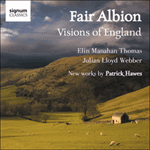
Welcome to Hyperion Records, an independent British classical label devoted to presenting high-quality recordings of music of all styles and from all periods from the twelfth century to the twenty-first.
Hyperion offers both CDs, and downloads in a number of formats. The site is also available in several languages.
Please use the dropdown buttons to set your preferred options, or use the checkbox to accept the defaults.

There are many variations of the Propers for a requiem, and composers have used various configurations to serve their own creative ends. The text of the Lazarus Requiem follows that used by Fauré very closely—except at the very end where the traditional reference to Dives and Lazarus has been omitted (as this refers to a different Lazarus.) Fauré’s Requiem selects all the texts that point to heaven and the hope of the resurrection. In the same way, the Lazarus Requiem emphasises the victory of Christ over death, but does not evade the pain and confusion that death leaves in its wake. The eleventh chapter of St. John’s Gospel figures heavily in the funeral rites of the reformed tradition, stressing the need for the personal recognition of Jesus as ‘the resurrection and the life’. In this way, the Lazarus Requiem opens up a truly catholic perspective on the Christian experience of death and dying.
There are various examples of the liturgical sequence of the requiem being used as a framework to carry other texts: Britten’s War Requiem is one English example. In the Lazarus Requiem the text, with the exception of one original poem, is from the New Testament. In this way, the liturgical text and the scripture throw light upon one another and so illuminate the hearts and minds of all those who perform and listen in a ‘double light’. It is possible both to extract the Latin texts and use them as a liturgical setting, or to extract the narrative of the Gospel and perform a dramatic cantata. Many of the ‘movements’ also stand alone for concert or liturgical performance.
The work begins with an orchestral Elegy for Lazarus which depicts the dying man and sets the scene for the first tableau. The sound worlds of the tableaux and the Latin movements are quite different. The Requiem aeternam, Kyrie, Sanctus etc. use the full resources of both choir and orchestra whereas the tableaux, as well as using semi-chorus, are characterised by muted strings, harp and baritone saxophone. Christ’s solos see the addition of the four horns. There are moments when the two sound worlds become superimposed. Most notably, the Benedictus takes the form of a soprano solo sung by Mary and, at the climax of the miracle when Christ exclaims, “Unbind him! Loose him! Let him go!” the mutes are removed from the strings, and the full orchestra interject with the concluding section of this tableau. The final movement of the work is the Lux aeterna, for choir and orchestra, together with the two female soloists.
from notes by Andrew Hawes & Patrick Hawes © 2012
 Hawes: Fair Albion Hawes: Fair AlbionApril 2009 saw the release of Patrick’s latest delightful album Song of Songs which was made an album of the week on Classic FM.» More |

